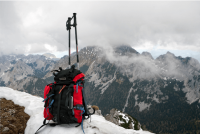Iceland – as its name suggests – has its fair share of cold, bleak days. As a rule of thumb, temperatures can drop to the exceptionally chilly −22 °F (−30 °C) in the highlands – albeit during very extreme periods of cold weather. If you’re visiting in winter, expect temperatures around the country to hover at the frosty 32 °F (0°C) mark and before you pack, remember that ideal Iceland clothing centers around two basic principles: layering and wind protection.
Known to vary from hour to hour and day to day, Iceland’s cold weather conditions are compounded by one distinctive feature: as the locals say, “it is the wind that kills you, not the cold”. Take heed and invest in the following recommended items of clothing to guarantee you survive Iceland’s bitingly cold winds.
Essential Iceland clothing for a summer or winter adventure:
1. Woolens
The Icelandic wool known as Lopi is made from the fleece of Icelandic sheep. Sweaters and other garments knitted from this material are known to be breathable, exceptionally warm, light and cozy – qualities that make it ideal for the unforgiving winter temperatures in Iceland.
Hand knitted, traditional patterned sweaters have seen a comeback in terms of Icelandic fashion over the last few years and a whole new generation of shops selling this iconic garment have sprung up around the country. If you’re looking to stay warm and blend in with this locals, this is the one Iceland clothing item that you can’t travel without.
 But to be even more snug, woolen hats and scarves knitted from Lopi are the ideal way avoiding catching a chill in Iceland. Be aware that the fibers of the wool can cause itchiness when worn directly against the skin, so make sure you wear a high-necked base layer to preempt any irritation.
But to be even more snug, woolen hats and scarves knitted from Lopi are the ideal way avoiding catching a chill in Iceland. Be aware that the fibers of the wool can cause itchiness when worn directly against the skin, so make sure you wear a high-necked base layer to preempt any irritation.
2. Layers made from synthetic fibres
One of the best principles for dressing to survive the windy Icelandic weather is layering. The beauty of investing in a number of garments made from synthetic fibers which can be layered over one another is that this allows you to respond quickly to changes in temperature, by either adding or removing a layer.
A base layer plus breathable mid-layers, such as micro fleeces or other sweaters made from breathable material, are the ideal combination to insulate your body against the cold by trapping warm air between the layers. Quick drying synthetic fabrics, such as acrylic and polyester or breathable nylon are excellent choices when selecting your Iceland clothing as they help to wick away moisture while insulating you from the cold.
3. Waterproofs
In a country where heavy showers and biting winds are the norm throughout the year, a high-quality waterproof jacket is essential by providing excellent protection from the fiercest of the Icelandic elements.
 Waterproof pants, a pair of breathable but water resistant walking trousers and waterproof gloves are indispensable when trekking in Iceland, as they’ll keep you warm and dry, even in the wettest of conditions.
Waterproof pants, a pair of breathable but water resistant walking trousers and waterproof gloves are indispensable when trekking in Iceland, as they’ll keep you warm and dry, even in the wettest of conditions.
4. Hiking boots
Waterproof hiking boots which provide ankle support are essentials, not only to comfortably support your feet when clambering over Iceland’s rugged terrain, but to stop water and snow from entering the shoe.
 Ensure they have good grip underneath to give you extra peace of mind when trekking over wet terrain.
Ensure they have good grip underneath to give you extra peace of mind when trekking over wet terrain.
5. Thermal underwear
Good quality thermal underwear can provide insulation at nighttime but also act as an additional layer beneath walking trousers and waterproof pants. This essential piece of Iceland clothing can be made from synthetic fibers, merino wool or silk; all three are considered excellent at removing perspiration from the skin and keeping your body temperature regulated, even in very windy or cold conditions.
6. Swimwear
It might seem counterintuitive to pack swimwear if visiting Iceland during winter, but a soak in one of the many geothermal pools in spectacular settings in the Icelandic countryside is a classic experience. With waters reaching up to a toasty 100°F (38°C), you’ll barely notice the chilly outdoor air once you’re firmly ensconced in the waters.
No comments yet
There are no comments on this post yet.






Leave a comment